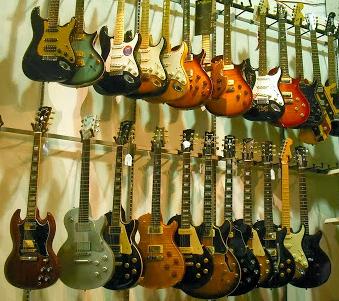A TWO-MINUTE ELECTRIC GUITAR COMPARISON

Here is a quick comparison of some archetypal guitars:
Les Paul - Upside: with moderate gain, single-string leads sustain forever and are extremely full, making them great for legato work. In fact, I'm amazed at the number of Strat players who gain up their guitars with pedals so that their single string lead sound is thick like a Les Paul. Les Pauls offer great crunchy rhythm. In the middle position the blend between pickups is continuously variable. Humbuckers reject LOTS of noise. Downside: They lack an entire octave of overtones the Strats have and two of the sounds as well. They can get too thick really quick. They can be a bit lackluster as a clean rhythm guitar, except for some very specific sounds. The older you are, the heavier they seem.
ES-335 - Very much like the Les Paul but somewhere between a Les Paul and a Strat as far as sound is concerned. There are more overtones available and less midrange "chunk" than a Les Paul and it is quite a bit "sweeter" sounding with an airier body sound mixed in. It is sweeter than a Strat as well. Eric Johnson played "Cliffs of Dover" on an ES-335. It has many of the ups of other guitars plus that semi-hollow sound. Buuuut, a semi-hollow guitar is more susceptible to feedback than LPs and Strats.
Gibson SG - The solid mahogany body make this guitar slightly brighter than an ES-335 with less body chunk as well. It is a good middle ground between an ES-335 and a Fender Tele but is less noisey than the Tele.
Strat - Ups: Lots of tones. Lots of overtones. Vibrato tailpiece (on some). Sweetness or brashness, depending on how you set your guitar and amp. Spank, latex, and quack. That volume control is perfectly placed for swells with the little finger. Downs: significantly less gain than an LP. Significantly less sustain than an LP. Significantly more induced noise than an LP. Trem tailpiece and its complications.
Tele - Ups: A very solid instrument with a fuller sound and more sustain than a Strat. Spank and lots of overtones to make effects interesting. The capability to be quite mellow with the tone control pulled down. Downs: the same as a Strat with more sustain and no trem.
Flying V - Ups: An interesting, spanky, banjo-ish sound that really cuts through a band. Surprisingly good sitting ergonomics when you learn to work them (neck up, V over right leg). Downs: An interesting banjo-ish sound...
Explorer - Between an LP and a Flying V in sound but with no spank. Not fun to sit down with though.
Firebird reverse - Lots of sustain with a brighter, thinner sound but reminiscent of an LP. Downs - Banjo (through) tuners are kinda weird and the guitar can be neck-heavy.
Arguments over ergonomics are like arguments about Ford and Chevy: everyone has different tastes and absolute statements are unhelpful and fruitless. Standing, I find the Les Paul the most comfortable electric guitar out there. It fits in right under my ribcage with just the right natural neck tilt for easy access. Heavy but comfortable, with lots of space between the pickups and under the strings to make picking easy. Sitting, the Strat, Tele, and ES-335 are more comfortable. The low altitude of the strings over the Fender bodies takes some getting used to, as does the Strat's middle pickup right where you want to pick. There's the whole long-versus-short-scale thing and, in my opinion, it is entirely down to preference. However, the two scales tend to breed two different left-hand vibrato techniques: Short-scale players tend to anchor the proximal joint of the index finger and rotate the wrist around it with the neck relatively static. Long-scale players tend to shake the whole neck, probably because of the increased tension. Basically, remember to always play an LP with a strap, standing or sitting, and position Gibsons with the neck up like a classical. Fender players seem to like their guitars more horizontal.
Each of these guitars has a use in the arsenal and a place in the guitar universe. You've just gotta learn to work 'em.
= =
=

